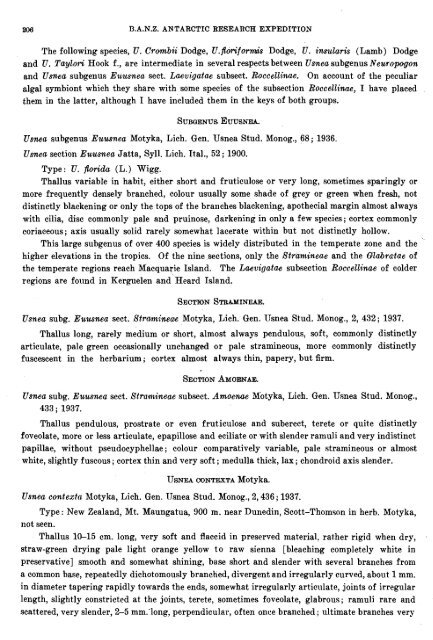You also want an ePaper? Increase the reach of your titles
YUMPU automatically turns print PDFs into web optimized ePapers that Google loves.
a06 B.A.N.Z. ANTARCTIC RESEARCH EXPEDITION<br />
The following species, U. Crombii Dodge, U.jloriformcis Dodge, U. insularis (Lamb) Dodge<br />
and U. Taylori Hook f., are intermediate in several respects between Usnea subgenus Neuropgon<br />
and Usma subgenus Euz~snea sect. Laevigatae subsect. Roccellinae. On account of the peculiar<br />
algal symbiont which they share with some species of the subsection Roccellinae, I have placed<br />
them in the latter, although I have included them in the keys of both groups.<br />
Usnea subgenus Euwnea Motyka, Lich. Gen. Usnea Stud. Monog., 68; 1936.<br />
Umea section Euusnea Jatta, Syll. Lich. Ital., 52 ; 1900.<br />
Type: U. jtom'da (L.) Wigg.<br />
Thallus variable in habit, either short and fruticulose or very long, sometimes sparingly or<br />
more frequently densely branched, colour usually some shade of grey or green when fresh, not<br />
distinctly blackening or only the tops of the branches blackening, apothecial margin almost always<br />
with cilia, disc commonly pale and pruinose, darkening in only a few species; cortex commonly<br />
coriaceous; axis usually solid rarely somewhat lacerate within but not distinctly hollow.<br />
This large subgenus of over 400 species is widely distributed in the temperate zone and the '<br />
higher elevations in the tropics. Of the nine sections, only the Strantineae and the Glabratae of<br />
the temperate regions reach Macquarie Island. The Laeviga.tae subsection Roccellinae of colder<br />
regions are found in Kerguelen and Heard Island.<br />
Usnea subg. Euusnea sect. Strawtineale Motyka, Lich. Gen. TJsnea Stud. Monog., 2, 432; 1937.<br />
Thallus long, rarely medium or short, almost always pendulous, soft, commonly distinctly<br />
articulate, pale green occasionally unchanged or pale stramineous, more commonly distinctly<br />
fuscescent in the herbarium; cortex almost always thin, papery, but firm.<br />
SECTION AMO~AE<br />
Usnea subg. Euusnea sect. Strawnineae subsect. Amoenae Motyka, Lich. Gen. Usnea Stud. Monog.,<br />
433 ; 1937.<br />
Thallus pendulous, prostrate or even fruticulose and suberect, terete or quite distinctly<br />
foveolate, more or less articulate, epapillose and eciliate or with slender ramuli and very indistinct<br />
papillae, without pseudocyphellae; colour comparatively variable, pale stramineous or almost<br />
white, slightly fuscous; cortex thin and very soft; medulla thick, lax; chondroid axis slender.<br />
USNEA CONTEXTA Motyka.<br />
Usnea contexta Motyka, Lich. Gen. Usnea Stud. Monog., 2,436 ; 1937.<br />
Type: New Zealand, Mt. Maungatua, 900 m. near Dunedin, Scott-Thomson in herb. Motyka,<br />
not seen.<br />
Thallus 10-15 cm. long, very soft and flaccid in preserved material. rather rigid when dry,<br />
straw-green drying pale light orange yellow to raw sienna [bleaching completely white in<br />
preservative] smooth and somewhat shining, base short and slender with several branches from<br />
a common base, repeatedly dichotomously branched, divergent and irregularly curved, about 1 mm.<br />
in diameter tapering rapidly towards the ends, somewhat irregularly articulate, joints of irregular<br />
length, slightly constricted at the joints, terete, sometimes foveolate, glabrous; ramuli rare and<br />
scattered, very slender, 2-5 mm:long, perpendicular, often once branched ; ultimate branches very

















